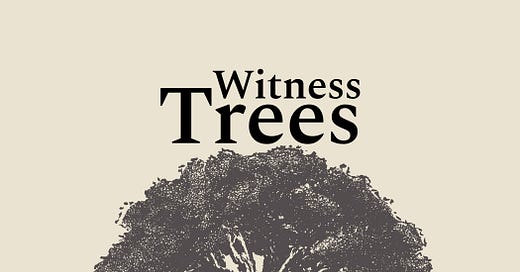Where my imaginary line Bends square in wood, an iron spine And pile of real rocks have been founded. And off this corner in the wild, Where these are driven in and piled, One tree, by being deeply wounded, Has been impressed as Witness Tree And made commit to memory My proof of being not unbounded. Thus truth’s established and borne out, Though circumstanced with dark and doubt— Though by a world of doubt surrounded.
“Who cut down the fig tree, Aunt?”
Mourid Barghouti asks his Aunt upon returning to Palestine after a 30 year banishment. He travels to his birthplace, Dar R’ad, and looks for the fig tree—“solid in my memory”—that used to stand broad-leafed and tall in the courtyard of his childhood home, a home filled with siblings and aunts and cousins in one big living situation, but he finds no tree. It’s been cut down.
“I’ve grown old and weak,” his Aunt replies, “People have emigrated and people have died. To whom should I feed the figs, my son? The figs stay on the tree till they dry and litter the whole yard.”
Do you know what a Witness Tree is?
It’s a tree that stands in a place where significant events—often death and war—have occurred, standing as a testament to what happened there, because humans move on, live, forget, and die. But the tree remains. It’s a physical reminder for our easily distracted and capricious memories.
There are witness trees on the battlefields of the Civil War, at Manassas, and Shiloh, and Gettysburg. There are witness trees on the fields of France. There are witness trees in Dar R’ad. There are witness trees surrounding Bergen-Belsen, Auschwitz, Dachau. And one day there will be witness trees in Gaza and Israel.
The country of Bhutan is squashed between Nepal, Tibet, and India. It’s a small country, only 777,000 people live there, and is reported as one of the happiest places on earth.
There may be a host of explanations for why that’s the case when the average Bhutanese person makes the equivalent of $225 per month and much of the country is still underdeveloped (there isn’t even one stoplight), but the Bhutanese themselves attribute it partly to a ‘national pedagogy’ that includes contemplation of death on a daily basis.
If America has a national pedagogy at all, and in this day it’s questionable that anything could be considered so ubiquitous, it might be “get rich or die trying”. But in Bhutan, says Dasho Karma Ura, “…we learn that to see yourself as not always a living person, but also a dying person, is a very important pedagogy of life. Death here is part of the culture and communication.”
When I read about the Bhutanese in Michael Easter’s book The Comfort Crisis, it shocked me, jolting me into contemplating my own death more often. And what I found is that contemplating my death—on my front porch, driving in the car, while eating dinner—gives me perspective and makes me want to be a more magnanimous person, because contemplating my own death makes me ask questions like, “How do I want to be remembered?” and that leads me to wonder how I’m treating people now and living my life now. This act of contemplation shrinks the psychological distance between my future death and my present moment, making me more aware and engaged.
Keep reading with a 7-day free trial
Subscribe to The Portmanteau to keep reading this post and get 7 days of free access to the full post archives.




